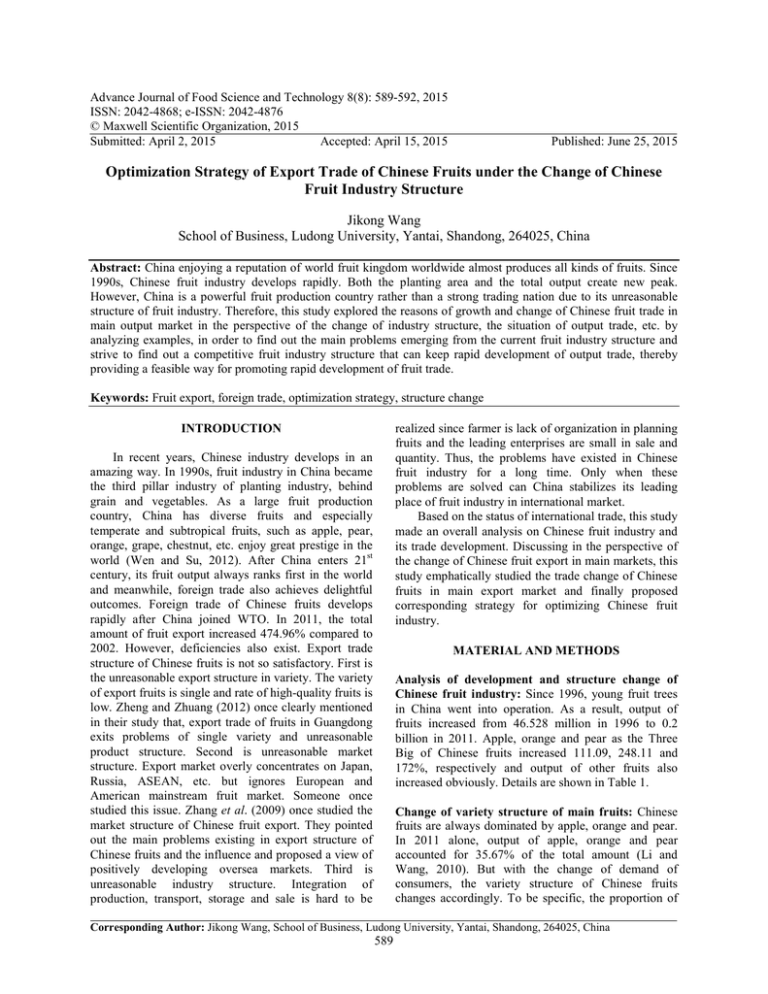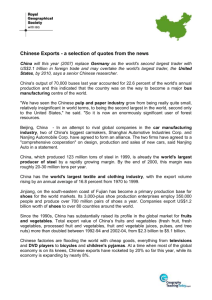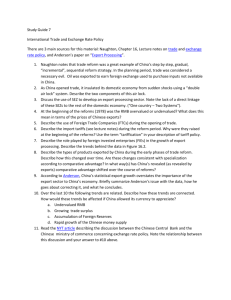Advance Journal of Food Science and Technology 8(8): 589-592, 2015
advertisement

Advance Journal of Food Science and Technology 8(8): 589-592, 2015 ISSN: 2042-4868; e-ISSN: 2042-4876 © Maxwell Scientific Organization, 2015 Submitted: April 2, 2015 Accepted: April 15, 2015 Published: June 25, 2015 Optimization Strategy of Export Trade of Chinese Fruits under the Change of Chinese Fruit Industry Structure Jikong Wang School of Business, Ludong University, Yantai, Shandong, 264025, China Abstract: China enjoying a reputation of world fruit kingdom worldwide almost produces all kinds of fruits. Since 1990s, Chinese fruit industry develops rapidly. Both the planting area and the total output create new peak. However, China is a powerful fruit production country rather than a strong trading nation due to its unreasonable structure of fruit industry. Therefore, this study explored the reasons of growth and change of Chinese fruit trade in main output market in the perspective of the change of industry structure, the situation of output trade, etc. by analyzing examples, in order to find out the main problems emerging from the current fruit industry structure and strive to find out a competitive fruit industry structure that can keep rapid development of output trade, thereby providing a feasible way for promoting rapid development of fruit trade. Keywords: Fruit export, foreign trade, optimization strategy, structure change realized since farmer is lack of organization in planning fruits and the leading enterprises are small in sale and quantity. Thus, the problems have existed in Chinese fruit industry for a long time. Only when these problems are solved can China stabilizes its leading place of fruit industry in international market. Based on the status of international trade, this study made an overall analysis on Chinese fruit industry and its trade development. Discussing in the perspective of the change of Chinese fruit export in main markets, this study emphatically studied the trade change of Chinese fruits in main export market and finally proposed corresponding strategy for optimizing Chinese fruit industry. INTRODUCTION In recent years, Chinese industry develops in an amazing way. In 1990s, fruit industry in China became the third pillar industry of planting industry, behind grain and vegetables. As a large fruit production country, China has diverse fruits and especially temperate and subtropical fruits, such as apple, pear, orange, grape, chestnut, etc. enjoy great prestige in the world (Wen and Su, 2012). After China enters 21st century, its fruit output always ranks first in the world and meanwhile, foreign trade also achieves delightful outcomes. Foreign trade of Chinese fruits develops rapidly after China joined WTO. In 2011, the total amount of fruit export increased 474.96% compared to 2002. However, deficiencies also exist. Export trade structure of Chinese fruits is not so satisfactory. First is the unreasonable export structure in variety. The variety of export fruits is single and rate of high-quality fruits is low. Zheng and Zhuang (2012) once clearly mentioned in their study that, export trade of fruits in Guangdong exits problems of single variety and unreasonable product structure. Second is unreasonable market structure. Export market overly concentrates on Japan, Russia, ASEAN, etc. but ignores European and American mainstream fruit market. Someone once studied this issue. Zhang et al. (2009) once studied the market structure of Chinese fruit export. They pointed out the main problems existing in export structure of Chinese fruits and the influence and proposed a view of positively developing oversea markets. Third is unreasonable industry structure. Integration of production, transport, storage and sale is hard to be MATERIAL AND METHODS Analysis of development and structure change of Chinese fruit industry: Since 1996, young fruit trees in China went into operation. As a result, output of fruits increased from 46.528 million in 1996 to 0.2 billion in 2011. Apple, orange and pear as the Three Big of Chinese fruits increased 111.09, 248.11 and 172%, respectively and output of other fruits also increased obviously. Details are shown in Table 1. Change of variety structure of main fruits: Chinese fruits are always dominated by apple, orange and pear. In 2011 alone, output of apple, orange and pear accounted for 35.67% of the total amount (Li and Wang, 2010). But with the change of demand of consumers, the variety structure of Chinese fruits changes accordingly. To be specific, the proportion of Corresponding Author: Jikong Wang, School of Business, Ludong University, Yantai, Shandong, 264025, China 589 Adv. J. Food Sci. Technol., 8(8): 589-592, 2015 Table 1: Output of main variety of Chinese fruits (10 thousand t) Apple Orange Pear Grape Banana Year Fruit 1996 4652.8 1704.7 845.7 580.7 188.3 253.6 1997 5089.3 1721.9 1010.2 641.5 203.3 289.2 1998 5452.9 1948.1 859.0 727.5 235.8 351.8 1999 6237.6 2080.2 1078.7 774.2 270.8 419.4 2000 6225.1 2043.1 878.3 841.2 328.2 494.1 2001 6658.0 2001.5 1160.7 879.6 368.0 527.2 1924.1 1199.0 930.9 447.9 555.7 2002 6952.0 2003 14517.4 2110.2 1345.4 979.8 517.6 590.3 2004 15340.9 2367.5 1495.8 1064.2 567.5 605.6 1132.4 579.4 651.8 2005 16120.1 2401.1 1591.9 2006 17102.0 2605.9 1789.8 1198.6 627.1 690.1 1289.5 669.7 779.7 2007 18136.3 2786.0 2058.3 2008 19220.2 2984.7 2331.3 1353.8 715.1 783.5 2009 20395.5 3168.1 2521.1 1426.3 794.1 883.4 2010 21401.4 3326.3 2645.2 1505.7 854.9 956.1 2011 22768.2 3598.5 2944.0 1579.5 906.7 1040.0 Chinese statistical yearbook (2012); output of fruits include melon from 2013 apple and pear tend to decrease first and then rise slightly and output of fruits which were not in a dominated place previously such as orange, banana and grape tend to increase year by year (Table 2). Position of the main fruits of China in the world: Output of Chinese fruits generally has scale advantage. Temperate fruits such as apple, orange, pear, grape, persimmon and peach, rank first in plating area and output in the world. In 2011, the output of apple, orange and pear in China account for 47.58, 23.28 and 66.73%, respectively in the world output, showing an obvious scale advantage, which lays a sound basis for promoting the export trade of fruits. Details are shown in Table 3. RESULTS AND DISCUSSION Table 2: Change of variety structure of Chinese main fruits (%) Year Apple Orange Pear Grape Banana 1996 36.64 18.18 12.48 4.05 5.45 1997 33.83 19.85 12.60 3.99 5.68 1998 35.73 15.75 13.34 4.32 6.45 1999 33.35 17.29 12.41 4.34 6.72 2000 32.82 14.11 13.51 5.27 7.94 2001 30.06 17.43 13.21 5.53 7.92 2002 27.68 17.25 13.39 6.44 7.99 2003 14.54 9.27 6.75 3.57 4.07 2004 15.43 9.75 6.94 3.70 3.95 2005 14.90 9.88 7.02 3.59 4.04 2006 15.24 10.47 7.01 3.67 4.04 2007 15.36 11.35 7.11 3.69 4.30 2008 15.53 12.13 7.04 3.72 4.08 2009 15.53 12.36 6.99 3.89 4.33 2010 15.54 12.36 7.04 3.99 4.47 2011 15.80 12.93 6.94 3.98 4.57 Chinese statistical yearbook (2012) Trade status of Chinese fruits in main output market: Overall analysis of export trade of Chinese fruits: It can be seen from Fig. 1 that, in recent years, import and export trade of Chinese fruits is steadily rising in a high speed and the export trade amount is always more than import trade amount, thus the net export amount is in a rising trend. It is worth noticing that, trade of China fluctuated obviously before and after China join WTO (Zhao, 2010). Before 2001, the net export amount was always in a decreasing tendency. While after 2001, the net export amount of fruit trade turned to steadily rise. Apparently, joining WTO promotes the progress of Chinese fruit trade. Table 3: Output of main fruits in China in 2011 and their positions in the world Output (10 Variety thousand t) Rank Proportion (%) Apple 3598.72 1 47.58 Pear 1594.5 1 66.73 Orange 2944.0 1 23.28 Banana 1070.57 5 10.05 Plum 587.37 1 51.71 Peach 1152.88 1 53.55 Grape 917.43 1 13.17 Mango 435.13 2 11.62 Persimmon 325.93 1 11.62 Pineapple 115.14 5 7.19 FAO database statistic Table 4: Structure of variety of main export fruits in China from 2010 to 2011 Output volume in Export amount 2010 (10 (hundred million Export structure thousand t) yuan) (%) Variety Fruits 507.52 26.79 100.00 Apple 112.30 8.32 31.06 Pear 43.78 2.43 9.07 Orange 93.31 6.16 22.99 Nuts 7.18 2.87 10.71 Banana 0.86 0.06 0.22 Grape 12.92 1.75 6.53 Castanea 3.71 0.74 2.76 mollissima Almond peach 4.01 0.19 0.71 Melon 1.07 0.41 1.53 590 Area (thousand hm2) 2052.23 1131.80 2904.96 403.30 1702.85 767.35 568.45 472.80 729.89 60.30 Rank 1 1 1 2 1 1 4 2 1 5 Proportion (%) 43.05 70.12 31.47 7.82 68.24 48.86 8.02 9.33 90.13 6.52 Output volume in 2011 (10 thousand t) 479.54 103.46 40.28 90.16 7.73 1.02 15.44 3.78 Export amount (hundred million yuan) 31.88 9.14 2.86 7.26 3.15 0.07 2.64 0.76 Export structure (%) 100.00 28.67 8.97 22.77 9.88 0.22 8.28 2.38 5.51 1.04 0.37 0.52 1.16 1.63 Adv. J. Food Sci. Technol., 8(8): 589-592, 2015 Import and export growth rate (%) Output amount 200 Input amount 150 Net export 100 50 2011 2009 2010 2008 2007 2005 2006 2004 2003 2002 2001 1999 2000 1998 1997 0 1996 40 35 30 25 20 15 10 5 0 -5 -10 -15 -20 -50 -100 Fig. 1: Export status of Chinese fruits in recent years (1996-2011) northwest inland, the northeast border should be incorporated into national key development plan, to promote fruit production and special export. Variety of export fruits and the characteristics of market structure: As shown in Table 4, though main export fruits in China in recent two years increased in output, but the structure of variety changed little; the export volume of apple, pear and orange were still the top three and the proportion of these three fruits even exceeded 60% in the total export volume once in recent two years. In the view of the distribution of international export markets of Chinese fruits, the area of export of Chinese fruits concentrates on ASEAN, Japan, Russia, Netherlands and America. ASEAN as the largest trading partner of import and export of Chinese fruits remains to be first in the Chinese fruits export market over the years. In 2011, the output amount of Chinese fruits to ASEAN was 151.5 million yuan, accounting for 49, 90% of the total export amount of Chinese fruits, followed by Japan and Russia (Liu, 2011; Li, 2010). In a whole, export market of Chinese fruits concentrates on surrounding counties with regional advantage and every export country accounts for a large proportion of export quotas; ASEAN only accounts for almost the half of Chinese fruit export market (Zhang and Hu, 2011). Implementing branding strategy: To improve the competitiveness of product, promoting brand is one of the important factors. Thus in order to improve the overall level of Chinese fruit export, establishment of Chinese characteristics fruit brand should be strengthened. First, we should improve the technological level of fruit production (Mao and Kong, 2011), strengthen the establishment of quality standard system of fruits and the processed products and implement more perfect quality monitoring system for fruit brand. Secondly, we should pay more attention to the grading of fruits. Fruit production, transport process should be strictly monitored according to the market demand and standardized requirements. As to the transport of export fruits, the fruits should be washed, waxed, labeled, classified and packed as per international standard to improve the grade of fruits. Thirdly, brand building of export fruits should be strengthened. The government should support and encourage Chinese producers to build brand of characteristic fruits and identification number and register in related department of the government, to create producer brand and merchant brand and improve the freshness of Chinese fruit brand. At last, we should strengthen the promotion strength of brand. For instance, we can enhance the promotion strength of Chinese superior fruits in ASEAN and Russia, hold characteristic exhibition activity for Chinese fruits and organize fruit merchants from main market countries to come to characteristics fruit production area in China for them to fundamentally recognize the quality guarantee of Chinese characteristic fruits. Optimization strategy of Chinese fruit export trade: Strategy of exporting characteristic fruits: Optimizing structure of fruit variety is the priority among priorities in improving fruit export capacity currently. Based on the requirements of “optimizing industry, improving quality, enlarge scale and increase benefits”, we should do well in the regional distribution of characteristic fruits and establish fruit export zone facing ASEAN (Wang, 2011). Production of fruits such as apple, pear, orange, peach, cherry, Chinese data, apricot, walnut, persimmon which are complementary to ASEAN should be emphatically developed. In addition, fruit production should be developed focusing on the regional advantage, to make characteristic fruits be planted in the most suitable area. Moreover, fruit export area in the middle and lower reaches of Changjiang River, Huang-Huai-Hai, circum-Bohai-Sea, Implementing Industrialization development strategy: To promote the integration of production, processing, storage, transport, sale and service of Chinese export fruits, a system of production, processing, storage, transport, sale and service should 591 Adv. J. Food Sci. Technol., 8(8): 589-592, 2015 Chinese fruits in the view of structure optimization. It makes a contribution to industry upgrading, income growth of the peasants, food safety and stable and healthy development of the while national economy and provides important reference value for government and enterprises developing fruit industry and formulating decision programming of fruit trade. be established and perfected to comprehensively enhance the comprehensive competitiveness of Chinese fruit export. First, a group of leading export enterprises should be cultured, to act as a leading role, thereby motivate ability of storage, transport, processing and marketing of Chinese export fruits. Secondly, a group of seedling breeding bases for excellent fruits should be developed, to promote the quality and quality characteristics of export fruits. Thirdly, new management mode using order purchasing, processing, storage, transport and trade means should be implemented, such as “enterprise+base”, “enterprise+base+farmer”, to avoid inorganized planting behavior of planters. Fourthly, we should perfect the socialization service system of export fruits, strengthen science and technology service of production, processing and sale, information providing service, monetary circulation service, risk taking service and commercial inspection service, realize a coordinated process of production, processing, transport, storage and service and comprehensively enhance the export ability of Chinese fruits. REFERENCES Li, M.Q., 2010. Analysis on the impact of FTA between South Korea and ASEAN on China’s export of agricultural products to South Korea. Southeast Asian Stud., (3): 48-55. Li, X.Z. and B. Wang, 2010. International market power of Tilapia industry in China based on empirical analysis. Prob. Agric. Econ., (8): 70-75. Liu, M., 2011. Influencing factors analysis of green supply chain based on the ISM. Sci. Technol. Manag. Res., (12): 192-194. Mao, F. and X.Z. Kong, 2011. Analysis of influence factors of safety pesticide matching behavior of farmer. J. Agrotech. Econ., (5): 4-12. Wang, L.F., 2011. Analysis of international competitiveness of Chinese fruits. Agric. Econ., (4): 28. Wen, S.M. and G.B. Su, 2012. Analysis of Chinese fruit export growth factors based on CMS model. Prob. Agric. Econ., (9): 17-23. Zhang, F.H., J.Q. Guo and X. Chang, 2009. Analysis on structure of exported China’s fruits. Manag. Agric. Sci. Technol., 28(4): 7-10. Zhao, J., 2010. Analysis on the main influencing factors of development scale to forestry industry in Yunnan based on ISM technology. J. Anhui Agric Sci., 38(26): 14690-14692. Zhang, F.H. and J.L., Hu, 2011. Research on competitiveness of Chinese fruits in ASEAN market. J. Int. Trade, (2): 74-81. Zheng, X.Y. and L.J. Zhuang, 2012. Analysis of characteristics and competitiveness of Guangdong fruit export trade. Shand. Econ., (6): 15-17. CONCLUSION Through analyzing the change of fruit industry structure and export trade, this study summarizes an optimization strategy beneficial for developing Chinese fruit industry. All in all, optimizing the structure of export trade of Chinese fruits must follow the demand of international markets, adjust production and trade structure according to the change of international market structure, thereby optimizing the industry structure. We should positively open up export market of fruits. To be specific, we should positively open up market in Russia, West Asia, Middle East, expand European and American market and try Africa and other markets, to avoid risk caused by excessive concentrated market. This study discusses the feasible means for promoting the rapid development trade and enhancement of international competitiveness of 592



